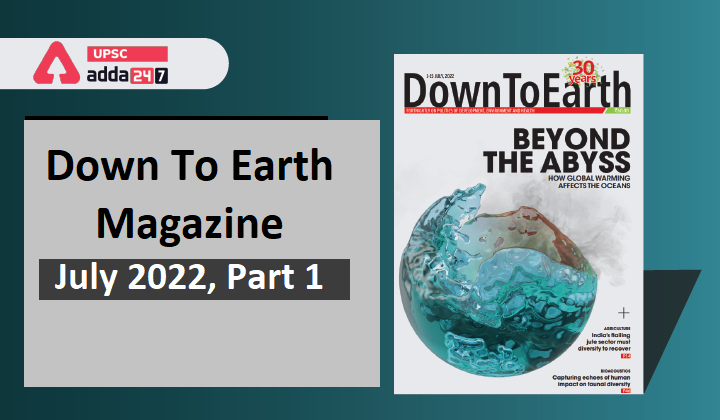Table of Contents
Down To Earth Magazine is a fortnightly magazine focusing on politics of environment and development, published in New Delhi, India.
UPSC Previous years’ questions on Development, Environment, Health and Disaster Management give us a clear idea about the increased importance of DTE Magazine.
DTE Magazine is one of the most important and indispensable source for UPSC Civil Services Exam Preparation. Keeping this in mind, here, we come with ”Gist Of Down To Earth Magazine” which covers important environmental current affairs articles in smooth pointed form, keeping in mind the demand of UPSC aspirants.
Deep-Sea Mining: Introduction
- The underwater world—without the energy of the sun and oxygen—is unique and beyond human imagination.
- Unfortunately, even before completely discovering and understanding it, there is a mad rush to exploit the vast resources through deep-sea mining.
- It is believed that drilling operations could start as early as 2026.
- According to an estimate, 50,000 m3 of sediment and other wastes will be released daily by a single polymetallic-nodule mining operation, if deep-sea mining is allowed.
Deep-Sea Mining: What is Deep Sea?
- Based on depth, the oceans are divided into zones, or for practical purposes, ecological zones.
- The upper portion (0 to 200 m) is called the photic. Sunlight reaches this zone, allowing photosynthesis to occur. Phytoplanktons—marine microalgae that produce 50 per cent of the world’s oxygen— live here.
- It also is inhabited by microscopic organisms zooplankton, crabs, shellfish, and jellyfish. Beneath the photic zone is the deep sea.
Deep-Sea Mining: Why World in a hurry?
- Deep-sea mining involves extracting massive polymetallic sulphide ore from hydrothermal vents, ferromanganese crusts from seamounts and polymetallic manganese ore from the sea floor.
- These ores are rich in cobalt, manganese, zinc, and other rare metals needed to build batteries for electric vehicles and renewable energy, smartphones and laptops.
- As of May 2022, the International Seabed Authority (ISA), an intergovernmental body tasked with managing deep-sea mining activities, has allocated 31 contracts to explore deep-sea mineral deposits.
- More than 1.5 million sq km of the international seabed, roughly the size of Mongolia, has been set aside for mineral exploration, according to IUCN.
Deep-Sea Mining: What will be mined from the deep ocean?
One of the main aims of the mission is to explore and extract polymetallic nodules. These are small potato-like rounded accretions composed of minerals such as manganese, nickel, cobalt, copper and iron hydroxide. They lie scattered on the Indian Ocean floor at depths of about 6,000 m and the size can vary from a few millimetres to centimetres. These metals can be extracted and used in electronic devices, smartphones, batteries and even for solar panels.
Deep-Sea Mining: What is India’s Involvement?
- ISA has allocated India 75,000 sq km for mining polymetallic nodules. The estimated resource potential of the nodules is 380 million tonnes, containing 4.7 million tonnes of nickel, 4.29 million tonnes of copper, 0.55 million tonnes of cobalt and 92.59 million tonnes of manganese.
- The National Institute of Ocean Technology in Chennai has developed Varaha, a self-propelled seabed mining machine to collect polymetallic nodules. It is tasked with collecting and pumping nodules from depths of up to 6,000 m.
Deep-Sea Mining: The International Seabed Authority (ISA)
The International Seabed Authority (ISA), an autonomous international organisation established under the 1982 United Nations Convention on the Law of the Sea, allots the ‘area’ for deep-sea mining.
Deep-Sea Mining: What will be the environmental impact?
- Mining has the potential to disturb the fine ecological balance underwater.
- In deep-sea mining, a ship would unload a collector vehicle into the sea, which would then travel down to the seabed. Once at the site, it would scrape off the top 10 cm of the seabed at multiple locations.
- After picking up the nodules, the collector vehicle will pump the ore to the ship through a pipe. Once the ore reaches the surface, sediments are further removed from the nodule, and the waste is discarded into the oceans.
- According to the International Union for Conservation of Nature (IUCN), these deep remote locations can be home to unique species that have adapted themselves to conditions such as poor oxygen and sunlight, high pressure and extremely low temperatures. Such mining expeditions can make them go extinct even before they are known to science.
Conclusion
The deep sea’s biodiversity and ecology remain poorly understood, making it difficult to assess the environmental impact and frame adequate guidelines.



 TSPSC Group 1 Question Paper 2024, Downl...
TSPSC Group 1 Question Paper 2024, Downl...
 TSPSC Group 1 Answer key 2024 Out, Downl...
TSPSC Group 1 Answer key 2024 Out, Downl...
 UPSC Prelims 2024 Question Paper, Downlo...
UPSC Prelims 2024 Question Paper, Downlo...





